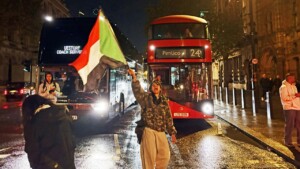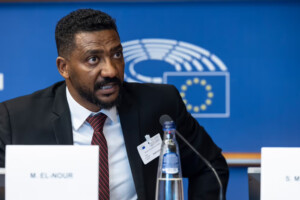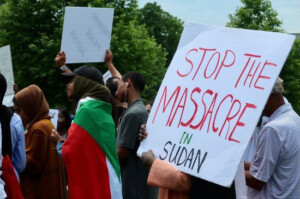Sudan uprising: Timeline of tumultuous change
As the ruling Sudan junta, and opposition agree on power-sharing, this timeline compiled by Radio Dabanga gives an overview of the events from the overthrow of Al Bashir on April 11 that have changed Sudan irreversibly, and continue to develop every day.
 Demonstration in Khartoum, May 31, 2019 (RD)
Demonstration in Khartoum, May 31, 2019 (RD)
2019 has already proven a watershed year in the history of Sudan. A popular uprising grew out of fuel and bread riots on December 19, 2018 in Atbara in north-eastern Sudan. Within three weeks, the uprising had spread across the country. Undaunted by brutal government suppression, the revolt culminated in the Khartoum sit-in, mass civil disobedience, and the overthrow by military coup d'état of the 30-year dictatorship of Omar Al Bashir, who himself seized power in a 1989 putsch. These dramatic events have left no part or aspect of the country untouched. The post-Al Bashir power struggle has seen levels of violence and brutality to rival the former regime, and ridding Sudan of remnants of the ‘deep state’ is an ongoing theme on the road to a free and democratic Sudan. However today, there is also a sense of hope for a brighter future, that could not have been imagined a year ago.
Radio Dabanga has been at the forefront of coverage from the start. As the ruling Sudan junta, and opposition agree on power-sharing, this timeline gives an overview and perspective of the events from the overthrow of Al Bashir on April 11 that have changed Sudan irreversibly, and continue to develop every day.
Mass protests led to the fall of President Omar Al Bashir on April 11. A Transitional Military Council (TMC) took-over power. Widespread protests, marches, vigils, and strikes continued, organised by the Forces for Freedom and Change (FFC) and its spearhead, the Sudanese Professionals Association (SPA), urging the junta to cede power to a civilian government.
The TMC demanded the protests to stop, and called for the dispersal of the mass sit-in in front of the army command in Khartoum. When the protestors did not comply, members of the Rapid Support Forces (RSF), Sudan’s main government militia, violently dispersed them in the early morning of June 3, the last day of the Muslim fasting month of Ramadan. In what became known as the ‘Khartoum Massacre’, at least 127 people were killed, hundreds injured, and dozens were reportedly raped. More than 100 people went missing.
People continued their demands for freedom, justice, and a civilian-led government. On June 30, thousands of Sudanese joined the ‘Marches of Millions’ that took place in various parts of the country. At least five demonstrators were killed that day.
Brokered by the African Union and Ethiopian mediators, the TMC and FFC agreed on a basic power-sharing agreement on July 5. During a transitional period of 39 months, a Sovereign Council, consisting of military and civilians, and a technocratic Cabinet will govern the country.
The various stakeholders reacted differently to the Political Agreement. While the international community and the National Umma Party welcomed the deal, the armed movements and the displaced people in Darfur rejected the contents of the document.
Rallies and vigils continued calling on the TMC to hand over power. The Sudanese Doctors Central Committee reported on July 18 that at least 246 people were killed and 1,353 injured since the outbreak of the anti-government protests in mid-December.
Demonstrators also called for fair retribution for the protestors killed. On July 30, mass rallies erupted across Sudan, after RSF militiamen shot dead four protesting secondary school students and an activist in El Obeid, capital of North Kordofan.
The ruling junta and the pro-democracy movement continued to negotiate the exact terms of the Political Agreement in July. Meanwhile, an FFC delegation met with members of the Sudan Revolutionary Front (SRF, a coalition of armed movements) in Addis Ababa, to discuss the inclusion of the position of the SRF on the peace process stipulated in the agreements.
On August 3, the TMC and FFC agreed on the text of the 250-pages Constitutional Declaration. Immediately after the ceremonial signing of the document, scheduled for August 17, the new government is supposed to begin its work.
After an overview of the events that led to the removal of Al Bashir, Radio Dabanga has compiled now a summary of the events following the military coup on April 11.
April 2019: Al Bashir ousted. Start of negotiations between the TMC and FFC.
April 11: The military seizes power and deposes President Omar Al Bashir. Minister of Defence Lt Gen Awad Ibn Auf sworn-in as interim president.
April 12: Demonstrations continue, calling for “real change”, as the protestors consider Ibn Auf a symbol of the Al Bashir regime.
April 13: Ibn Auf stands down. Lt Gen Abdelfattah El Burhan sworn-in as interim president of Sudan, RSF militia commander Mohamed Hamdan ‘Hemeti’ becomes interim vice-president.
April 14: International community acknowledges the ruling junta.
April 15: Sit-ins across the country demand a civilian-led transitional government.
April 16: Demonstrators demand release of all political detainees.

April 17: Artists cover walls near the sit-in in front of the army command in Khartoum with paintings commemorating protestors killed during the uprising.
April 18: The FFC alliance presents its vision regarding an interim civilian government.
April 19: Hundreds of thousands of people all over Sudan take to the streets again, calling for a civilian-led government.
April 21: Senior journalist reports that the military decided to depose Al Bashir after he ordered them to end the Khartoum sit-in by ‘killing 30-50 per cent of them”.
April 22: The ruling junta warns protestors at the Khartoum sit-in to stop blocking roads near the army command.
April 23: Protestors from Atbara in northern Sudan reach Khartoum on the “Freedom Train”, protestors killed in several towns.
April 25: The TMC replaces three Islamist members after pressure from the opposition.
April 26: Mass marches in Darfur. Top Sudanese rapper Ayman Mao flies-in from USA to wow Khartoum crowds.
April 27: Start of official negotiations between the TMC and the FFC on an interim government.
April 28: Busloads of protestors from various places in the country arrive at Khartoum in support of the sit-in.
April 30: Armed movements say that the FFC is not negotiating on their behalf. Despite warnings from the junta, protestors continue blocking roads in Khartoum.
May 2019: TMC suspends, resumes talks with opposition alliance. Protests intensify.
May 1: The AU Peace and Security Council gives Sudan’s junta an extra 60 days to hand over power to a civilian-led government.
May 2: The TMC orders officials of the former Al Bashir regime to vacate government houses.
May 3: Protests against the ruling TMC continue to grow, Vice-President ‘Hemeti’ says that the junta does not want to hold on to power.
May 5: Thousands of people in Suakin in Red Sea state close a part of the Khartoum-Port Sudan highway, in support of the Sudanese uprising and in protest against drinking water and bread, and continuing power outages.
May 6: The ruling TMC agrees to proposals of the AU mediation team, led by Mohamed Lebatt.
May 7: The FFC adopts a new communication strategy.
May 8: Strikes, sit-ins swell in the country, barricades set-up near the Khartoum sit-in block trains moving to the west of the country. Authorities urge the protestors to clear the lines.

May 9: Protestors injured by security forces at Khartoum sit-in. TMC demands wider powers. US Deputy of State and FFC call on the junta to expedite the negotiations.
May 10: Security forces crush protests all over Sudan.
May 12: Sudanese lawyers open proceedings against the former president for orchestrating the 1989 coup.
May 13: RSF troops prevent people from reaching the sit-in in Khartoum. Protestors defy the heavily armed militiamen.
May 14: Five protestors and an army captain shot dead at the Khartoum sit-in by supporters of Al Bashir. USA warns for more violence against demonstrators. TMC and FFC resume negotiations.
May 15: Demonstrations against the shooting of protestors at the Khartoum sit-in. The TMC and FFC reach an initial agreement on how Sudan should be governed in a three-year transitional period. The junta says it will only continue its dialogue with the opposition after the barricades from the main roads in Khartoum have been removed.
May 16: Protestors welcome the TMC-FFC agreement.
May 19: Doctors in Blue Nile state down their tools after being attacked. RSF militiamen attempt to remove the roadblocks near the sit-in in Khartoum.
May 20: TMC resumes negotiations with the opposition.
May 21: Sit-ins in Khartoum and other cities in the country grow daily. The Sudan Troika and the AU urge the negotiators to “reach an early agreement”.
May 22: The Sudanese Professionals Association calls for a general strike and civil disobedience actions to pressure junta to cede power.
May 23: TMC warns that all government employees who will take part in the general strike will be fired.
May 24: Vigils demanding civilian rule throughout Sudan.
May 26: Umma Party leader El Sadig El Mahdi proposes civilian majority government with military president. A delegation of the Sudan People’s Liberation Movement-North (SPLM-N), headed by Deputy Chairman Yasir Arman arrives in Khartoum.
May 27: Sudan TV staff banned for taking part in protest.
May 28: General strike and vigils called for by the Sudanese Professionals Association to pressure the junta to hand over power, carried out throughout Sudan.
May 29: TMC Vice-President ‘Hemeti’ states that junta will not hand over all power to the opposition. Members of his RSF militia storm the Bank of Sudan and an electricity company, and beat up the employees.
May 30: General strike swells on second day.
May 31: FFC threatens with more civil disobedience actions after successful strike.
June 2019: More than 100 protestors killed in the “June 3 Massacre” in Khartoum
June 2: Al Jazeera TV channel banned from Sudan.
June 3: RSF militiamen violently disperse Khartoum sit-in, killing more than 100 demonstrators, and wounding hundreds of others.
June 4: Security forces and RSF militiamen break up sit-ins in other cities as well. Both the junta and the opposition suspend negotiations.

June 5: FFC calls for a new general strike.
June 6: Protests across Sudan against the “Khartoum Massacre”. Arrests of activists, roads opened by force.
June 7: Sudan Doctors Committee reports that 108 protestors are killed during the past seven days.
June 9: Start of second general strike called for by the FFC.
June 10: Four protestors killed on first day of general strike that gets massive support. The ruling TMC imposes an internet shut-down all over the country. SPLM-N delegation members forcibly deported to South Sudan.
June 11: Doctors say dozens of people were raped at the Khartoum sit-in on June 3.
June 12: TMC and FFC agree to resume talks. The FFC will suspend calls for another general strike.
June 13: Social media goes #BlueForSudan in solidarity of the victims of June 3. Donald Booth appointed as US Special Envoy to Sudan.
June 14: Employees dismissed, suspended, relocated for participating in the general strike.
June 15: Unamid suspends hand-over of more camps for displaced people to Sudan’s military.
June 16: Al Bashir hears fraud and other financial crimes charges ahead of trial.
June 17: An investigation by the military ‘shows’ that break-up of Khartoum sit-in was a mistake by the soldiers and not ordered by the TMC.
June 18: FFC announces new protests later that week.
June 19: FFC leaders threatened with arrest by TMC. International Criminal Court prosecutor calls for transfer of Al Bashir to The Hague.
June 20: Head of the TMC tells FFC to negotiate without preconditions.
June 21: Ethiopian mediator to hand proposal for solving the political crisis. The junta continues to lobby in Sudan for a new government.
June 22: Members of the FFC travel to Addis Ababa to meet with AU commissioner.
June 23: Medics sacked, doctors assaulted, lecturers detained for participating in strike.
June 24: FFC accepts Ethiopian mediation proposal for an interim Sudanese government. Demonstrations take place all over Sudan.
June 25: TMC sharply criticises the mediators’ initiative.

June 26: Sudan protests continue, leading up to ‘Marches of Millions’, planned for June 30.
June 27: Crackdown on protestors across Sudan by RSF militiamen.
June 28: RSF agents detain dozens of students in Khartoum.
June 30: Hundreds of thousands of people join the ‘Marches of Millions’ in Khartoum and other cities and towns. At least five protestors are killed and dozens injured.
July 2019: TMC and FFC agree on power-sharing
July 1: The TMC blames ‘infiltrators’ for the violence during ‘Marches of Millions’.
July 2: More demonstrations in the country. The junta accuses the opposition of “provoking” its forces.
July 3: Security forces launch a detention campaign among activists in Khartoum.
July 4: Massive demonstrations for civilian rule across Sudan. The internet shut-down continues.

July 5: Basic power-sharing agreement reached between FFC and TMC.
July 6: Armed movements denounce the agreement and call for a meeting with the FFC.
July 8: FFC cancels protests for the coming weeks, and organises public activities for support of its deal with the TMC.
July 10: Internet services restored in Sudan.
July 11: Social media reveal footage of militia abuses at the “June 3 Massacre”.
July 12: The ruling TMC says a coup has been foiled. Displaced in Darfur reject the contents of the power-sharing agreement.
July 13: The TMC and FFC begin negotiations on details of the basic agreement, to be stipulated in the Constitutional Declaration.
July 15: Demonstrations across Sudan in commemoration of the victims of the “June 3 Massacre”.
July 16: Sudanese university professors urge dismissal of university managers appointed by President Al Bashir.
July 17: The FFC and TMC sign the Political Charter, agreed on July 5.
July 18: The Sudan Revolutionary Front declares its categorical rejection of the political deal. The National Umma Party, as well as the international community welcome the agreement.
July 19: Marches in solidarity with rape victims. Protests in Khartoum dispersed with tear gas.
July 20: Leftist opposition says that Political Charter gives all power to the junta.
July 22: “June 3 Massacre” commemorated in protest vigils all over Sudan. The committee of inquiry ordered by the junta to investigate the deadly events at the Khartoum sit-in on June 3 presents its findings.
July 23: FFC members and rebel leaders of the SRF discuss the Political Charter in Addis Ababa.
July 24: Vigils across Sudan demand to know the fate of the people who went missing in Khartoum on June 3. TMC Vice-President Hemeti says he is in contact with a number of armed movements.
July 25: Another coup attempt foiled and a number of generals arrested.
July 26: FFC and armed movements agree in the Ethiopian capital on a “united version” of the FFC-TMC agreements. Tens of thousands of people demonstrate Sudan in solidarity with rape victims.
July 28: The legal committee of the FFC finalises its comments on the draft text of the Constitutional Declaration.
July 29: Four school children dead, 40-50 wounded, as militiamen open fire in El Obeid, capital of North Kordofan.

July 30: Protests erupt in the country, condemning the “El Obeid Massacre”. Governor of North Kordofan imposes curfew in a number of towns.
July 31: The Umma Party and the Darfur Bar Association separately contradict the report of the investigation by the attorney-general into the violent dismantling of the Khartoum sit-in on June 3. USA, African Union urge Sudan negotiators to hasten agreement.
August 2019: Constitutional Declaration concluded; government to be established
August 1: Trial of Al Bashir begins in Khartoum. The Communist Party of Sudan withdraws from negotiations with the TMC.
August 2: Demonstrators all over Sudan call for ‘fair retribution’.
August 3: Sudan junta, opposition reach agreement over Constitutional Declaration. Sovereign Council and Cabinet to be formed before the end of August.
Note: The dates given in this overview are the dates of publication of the news by Radio Dabanga. We aim to publish news on the same day; however, verification of facts sometimes dictates that news must be published the next day.
Our editorial independence means that we can continue to provide factual updates about ongoing protests to Sudanese and international actors, educate people about how to avoid outbreaks of cholera, and provide a window to the world for those in all corners of Sudan. Support Radio Dabanga for as little as €2.50, the equivalent of a cup of coffee.












 and then
and then